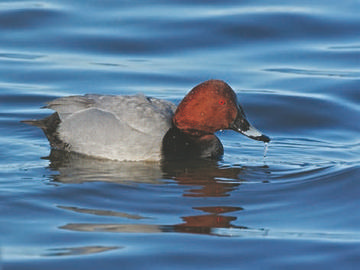
Pochard © Steve Round
Pochard is such a scarce breeder nationally that its numbers have been monitored by the Rare Breeding Birds Panel since 1986. Their latest report shows that, in 2004, the Cheshire and Wirral population was 15 pairs out of a national total of 482 pairs (Holling et al 2007). There are only seven counties with more breeding birds. It is misleading, however, to use the word ‘county’ here, because all of our regularly breeding birds are at just one site, Woolston Eyes, as they have been for more than twenty years. As was commented in our First Atlas, the Pochard’s breeding status in Cheshire depends mainly on the state of the Woolston sludge-beds, and the citation for the SSSI status of Woolston was amended in March 2004 to recognise the site’s value for nationally important numbers of breeding Pochard. There were at least 15 broods there in 2004, 22 broods in 2005 and 13-16 broods in 2006.
Their stronghold is clearly along the Mersey valley. In our First Atlas they were proved breeding only at Woolston and Doddington (SJ74D); now, twenty years on, breeding was confirmed only at Woolston (annually, in three tetrads) and Fiddlers Ferry (in 2006), with pairs of Pochards found in a further four tetrads. The Atlas map shows that there were single birds at a further eight sites but clearly few sites in the county provide their needs: Pochards are primarily vegetarian, diving for their food in shallow water with abundant plant-life, although they do take some small invertebrates. All of the birds were on standing water, and they can use quite small waterbodies; of the eight probable or confirmed records, one was on a pond less than 50 m2 (G1) and three on small waters up to 450 m2 (G2).
Pochards are fairly obvious when pairing, but females then withdraw to nest in dense emergent vegetation, and single males should be carefully watched. The earliest birds at Woolston start nesting in mid-April. Laying the typical clutch of 8-10 eggs, followed by 25 days incubation, leads to hatching in late May, with new broods from later birds emerging into July.
Sponsored by Tony and Margaret Hayter

